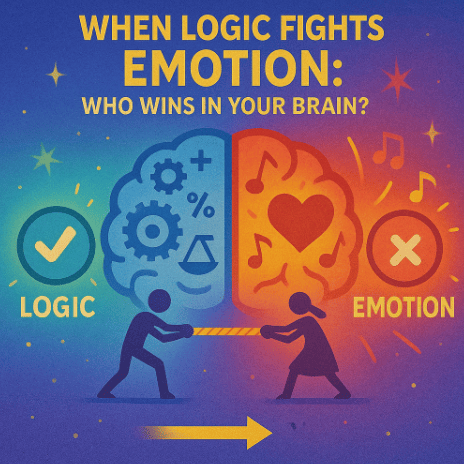
Recap Before We Begin 🔄
In Lesson 1, we saw how thoughts are built from neuron sparks.
In Lesson 2, we discovered the toolbox of problem-solving—trial and error, memory, logic, creativity, and shortcuts.
In Lesson 3, we learned about decisions, and how logic, emotion, habits, and chemicals like dopamine shape our choices.
Now, we zoom in on a common daily experience: that feeling when your head says one thing but your heart says another. Should you listen to logic, or to emotion?
The Two Main Players 🎭
Inside your brain, two regions are often at odds:
-
Prefrontal Cortex (Logic): This sits right behind your forehead. It’s responsible for planning, reasoning, and self-control. It’s the “voice of wisdom.”
-
Amygdala (Emotion): This is a small almond-shaped region deep in your brain. It’s quick to react, especially to danger, pleasure, or fear. It’s the “voice of feeling.”

When you face a tough choice, these two regions can give very different advice.
Example:
-
You’re on a diet. You see chocolate cake.
-
Prefrontal Cortex: “Don’t eat it. Too much sugar. Stick to your plan.”
-
Amygdala: “It looks so delicious! Eat it!”
-
And so the battle begins.
Why Emotions Are Fast ⏱️
The amygdala reacts much faster than logic. Imagine walking in the woods. You see something that looks like a snake.
Your amygdala immediately shouts, “Jump back!” even before your prefrontal cortex has time to check carefully whether it’s a stick or a snake.
This speed is helpful for survival. If our ancestors waited too long to “logically confirm danger,” they might not have survived lions or snakes. So emotions evolved to be fast alarms.
Why Logic Is Slow but Steady 🧮
The prefrontal cortex takes more time, but it is more accurate. After your amygdala screams “snake!” your prefrontal cortex examines carefully and might say, “Relax, it’s just a stick.”
This shows the two systems working together. Emotions protect you instantly, while logic double-checks and prevents false alarms.
When Emotion Wins ❤️🔥
Sometimes emotions overpower logic. This often happens when the emotional signal is very strong:
-
Fear → Running away without thinking.
-
Anger → Saying hurtful words before calming down.
-
Love → Taking risks you normally wouldn’t.
Neuroscientists call this “amygdala hijack.”
It means your emotional brain temporarily takes control, shutting down logical thinking. That’s why in heated moments, people often say or do things they later regret.
When Logic Wins 🧠⚖️
Other times, logic wins over emotion. For example:
-
You feel scared before a presentation. But your prefrontal cortex reminds you: “I prepared well. I’ll be fine.”
-
You want to buy something expensive, but logic says: “I can’t afford it right now.”
In these cases, self-control and reasoning override raw feelings. This is why the prefrontal cortex is sometimes called the “CEO of the brain.”
The Best Decisions: Balance 🧘
The truth is, neither logic nor emotion is always better. The brain works best when they balance each other.
-
Logic without emotion would make you cold and robotic.
-
Emotion without logic would make you reckless.
The wisest choices often come when logic listens to emotions, and emotions are guided by logic. For example: Choosing a career not only by salary (logic) but also by passion (emotion).
When Balance Breaks ⚠️
In some conditions, the balance breaks:
-
Too much emotion: In anxiety disorders, the amygdala is overactive, making people fear harmless situations.
-
Too much logic: In some brain injuries, people lose emotional responses and struggle to make decisions—even simple ones like choosing what to eat.
This shows how much we need both.
The Teenage Brain: A Battle in Progress 🎢
Did you know teenagers are especially famous for the “logic vs. emotion” battle? That’s because the prefrontal cortex (logic) develops much more slowly than the amygdala (emotion).
This means during teenage years:
-
Emotions shout louder than logic.
-
Teens may take risks (driving fast, trying dangerous stunts).
-
Logical brakes haven’t fully grown in yet.
Scientists sometimes joke that teenagers are “cars with strong engines (emotions) but weak brakes (logic).” As the prefrontal cortex matures in the mid-20s, balance improves.
Culture and Training the Balance 🌍
The fight between logic and emotion isn’t only biological—it’s also shaped by culture and training.
-
In some cultures, emotional expression is encouraged (e.g., openly showing joy or grief).
-
In others, logical control and restraint are valued (e.g., “Don’t cry in public”).
Also, practices like mindfulness meditation or cognitive behavioral therapy (CBT) actually strengthen the prefrontal cortex, making it easier to regulate emotions. In other words, the balance can be trained like a muscle.
The Role of Hormones 💉
Hormones—special body chemicals—also affect the balance.
-
Adrenaline: Released during stress, it boosts the amygdala and makes emotional reactions stronger. That’s why in emergencies, people sometimes panic.
-
Cortisol: The stress hormone. Too much of it weakens the prefrontal cortex, making it harder to think clearly.
-
Oxytocin: Sometimes called the “love hormone,” it strengthens emotional bonding, which can override logic in relationships.
So, decisions aren’t just brain sparks—they’re also influenced by body chemistry.
Conclusion 🌟
So when logic and emotion fight, there isn’t a single winner. Instead, the outcome depends on:
-
Your age (teens vs. adults).
-
Your brain chemistry (dopamine, cortisol, oxytocin).
-
Your training (meditation, therapy, self-control practice).
-
The situation (snake in the woods vs. choosing ice cream flavor).
The wisest human decisions come not from shutting down emotion, but from letting emotion and logic work as partners. Passion gives life its meaning, and reason helps keep that passion safe and productive.